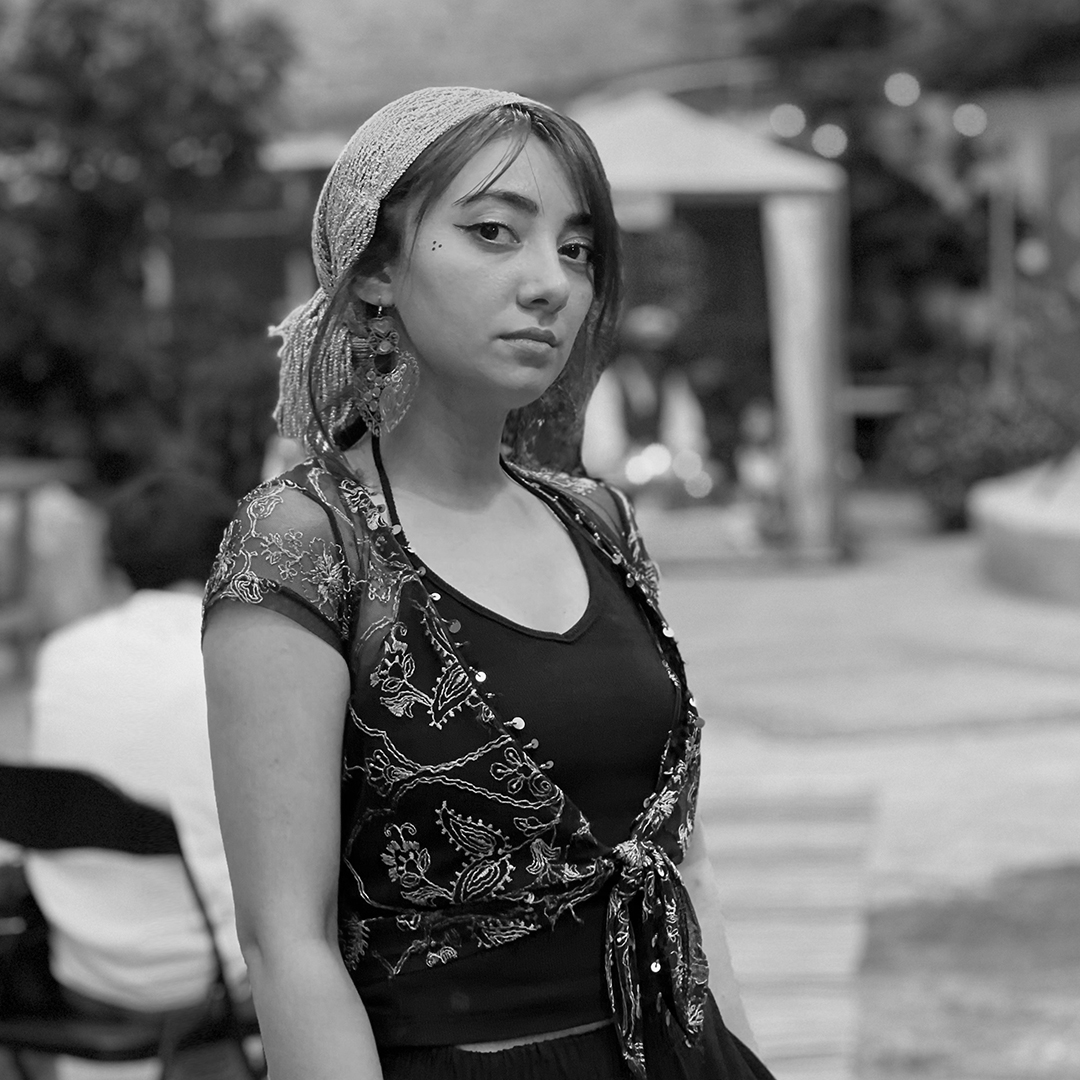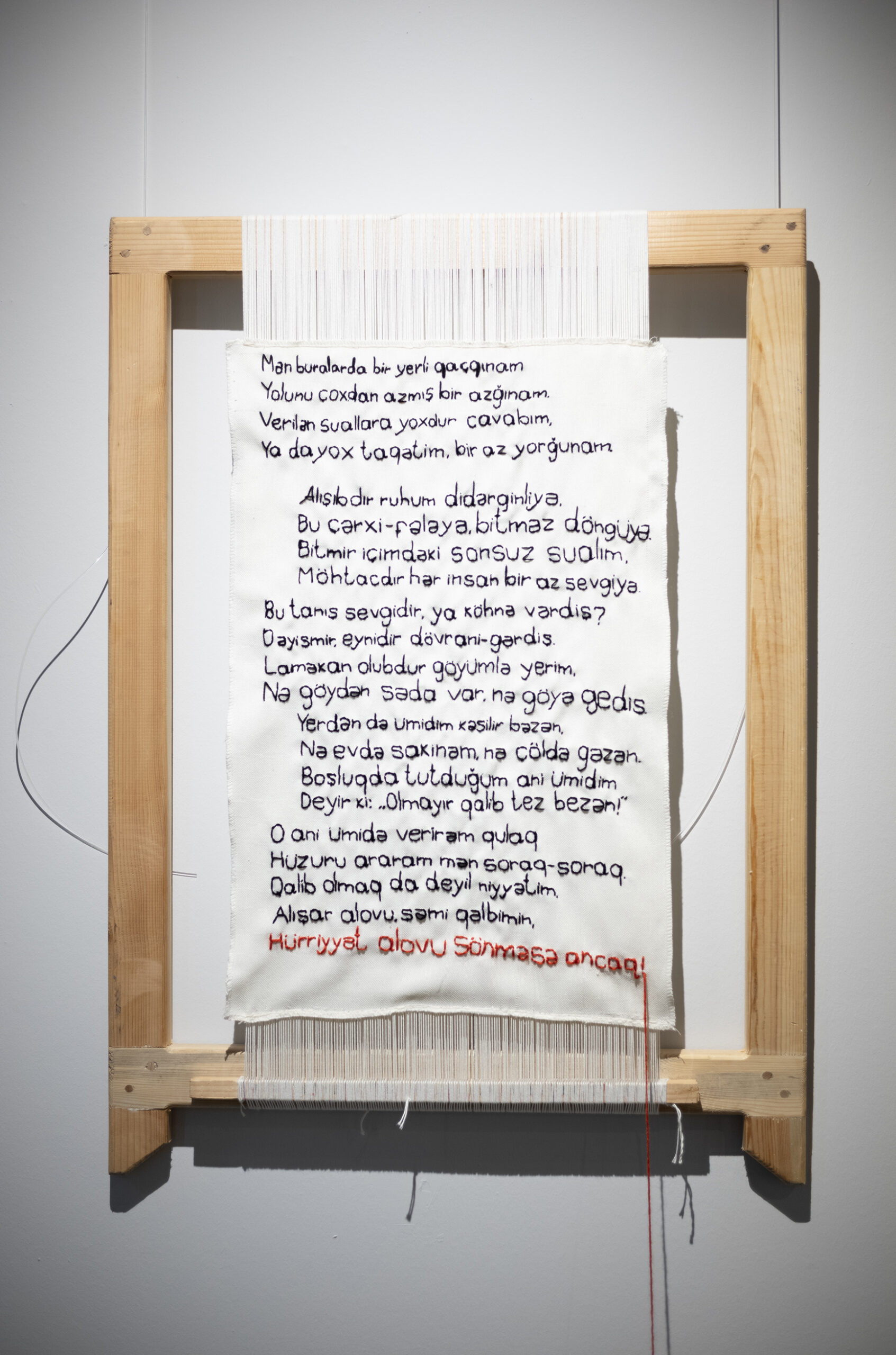
Ulkar Aliyeva

Toward the Light, 2025
Installation, carpet loom, white fabric, weaving threads, scissors
100 x 40 cm
On the loom’s white vertical threads, I have woven a poem in black yarn. The poem portrays a character struggling with inner conflicts and searching for freedom, only to realize that true freedom can only be found by achieving inner peace. While the poem starts with a sombre tone, it ends with an optimistic message. To symbolize this progression, the last line of the poem, representing freedom, is woven in red thread, while the black sections convey internal struggles.
Why a Carpet-Weaving Loom?
Carpet weaving relies on a loom to hold the vertical threads, known as warps, in place. The word “əriş” (warp) comes from the root “ar,” which conveys meanings such as “honour” and “purity.” It is why the warps are white, symbolizing purity. The coloured threads woven through them, known as wefts (arğac in Azerbaijani), represent external influences. The word “arğac” is derived from “ər,” which can mean “man” or “hero.” As the weaving process progresses, these threads intertwine, eventually forming a finished carpet—symbolizing a girl’s journey to maturity.
When the carpet is complete, the warp threads are trimmed to the desired length using a special carpet-cutting tool. I performed this process during the exhibition, cutting the woven poem carpet off the loom with scissors, symbolizing the freedom achieved through one’s efforts. The finished carpet, with the poem woven into it, is then displayed.
Carpet weaving has been a vital part of Azerbaijani women’s lives for centuries. Girls were taught this craft from a young age, and their carpets were often woven as part of their dowry. By adulthood, a girl’s dowry, including her carpet, was expected to be ready. This cultural tradition inspired my decision to use a loom for this piece.
A Journey of Inner Struggles and Freedom
In this artwork, the poem represents a woman’s inner struggles and her search for freedom. The white threads on the loom symbolize her pure yet burdensome role in life, while the poem woven in black threads expresses her inner thoughts, struggles, and pain. The transition from despair to optimism in the poem mirrors her journey toward finding inner freedom, with the final red words symbolizing hope, strength, and liberation.
The act of cutting the carpet from the loom during the exhibition represents breaking free from societal constraints and achieving personal freedom. This work highlights a woman’s journey toward inner peace and the power to “weave her freedom.”
Poem (A Translation with Possible Variations)
I am a refugee in my own land,
A stray who has lost its way for so long.
I have no answers to the questions asked,
Or maybe I’m just worn out and tired.
My soul has grown accustomed to restlessness,
Trapped in this cycle, endless loop.
The never-ending question inside me never ceases,
Only a little love does every heart need.
Is it a familiar love, or simply an old habit?
The cycle remains unchanged.
I belong nowhere, neither on the ground nor in the sky,
No sound from above, no journey to the heavens.
Sometimes, I lose hope even from the earth,
I am neither an inhabitant of a home nor a wanderer.
A fleeting hope is left hanging in the void, whispering,
“You can’t win if you give up too soon.”
I listen to that passing hope,
I search for my existence, I ask,
My purpose is not to win,
The burning flame, the candle in my heart,
But only if my flame of freedom doesn’t die out!
The Braids of the Bald Girl, 2025
Installation, mannequin-sculpture, artificial hair
170 x 50 cm
The phrase “Keçəl qızın hörükləri” (The Braids of the Bald Girl) is a longstanding expression in Azerbaijani, often carrying folkloric meaning. This phrase metaphorically refers to the idea of presenting something that doesn’t truly exist or is artificially created. In my artwork, this expression is directly represented: a bald figure adorned with braids. The concept of the bald figure is a recurring theme in my work.
This piece aims to minimize the external similarities between people, focusing instead on the exploration of emotions and psychological states. By removing identifiers such as gender, religion, race, or other societal labels, I strive to depict the pure essence of humanity. Initially, I created these bald figures exclusively as women. This decision, in addition to my broader artistic ideas, challenges the traditional view of female beauty, which is often symbolized by hair, and questions beauty as a relative concept. By erasing such symbols, I reject the imposed standards of beauty.
As time passed, the idea of baldness extended to figures across all gender identities in my work. Now, I focus on shaping the emotional expression of the face, leaving the viewer to interpret the identity of the character.
In this particular artwork, the bald girl has braids. However, these braids are not naturally a part of her body—they are an artificial attachment, wrapped tightly around her head and body like a constricting rope. This “hair” represents the external pressures and artificial expectations that many societies impose on girls as they mature. The artwork is completed with an artificial braid secured with a red ribbon at the centre. The detail of the ribbon, which feels like it could be undone at any moment, symbolizes a collective effort to liberate the figure and fulfil her longing for freedom.
This piece reflects the stereotypes and pressures society places on women. The braid stands for beauty standards and societal expectations, while the bald girl represents a modern woman who rejects these limitations and seeks freedom. The tightly wrapped braid illustrates both physical and emotional oppression. The work encourages viewers to reflect on how we can break free from societal constraints. It raises the question: “How can we break free from the rules that confine us?”
